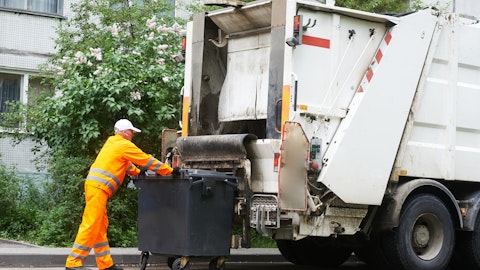So, it will ultimately continue to develop, and we are good with that. That extends life of our landfills, which are a non-replicable asset. It limits the timing on capital for landfills for expansion. And so it’s a process, it’s evolutionary that we feel very comfortable with overall.
Mary Anne Whitney: And I would just add to that, James, that of course increasing the recyclables we process ourselves is one of our sustainability objectives and we have been seeing growth every year, and we have built two new facilities and you added the latest technology and have 50 robotics units in operation at our facilities and continue to make investments. To Ron’s point, to make it an even better business and to de-risk it for ourselves because it’s a service we provide, but not in all cases, do we use our own recycling facilities. And so we have been advancing and improving that.
James Schumm: Okay. Great. Thanks. And then I am just wondering if landfill costs will rise at your other 100-plus landfills in 2024 to prevent another ETLF, like is there a change in strategy in the wake of events at the Chiquita landfill or should we not expect much change here?
Ron Mittelstaedt: Well, number one, I don’t think you should expect an incremental or step change increase in costs on our landfills because of what happened at Chiquita. What happened at Chiquita is, as we have said, ETLFs are very, very rare. They are a natural organic reaction that occurs under very unique circumstances. Can they happen elsewhere, they certainly can. But what I think is more important is what are we doing post-Chiquita that we have learned that would help to minimize the impact earlier on relative if one were to occur. And so we have made some engineering protocol changes of some more centralized landfill, well temperature monitoring on a more frequent basis. We have decided as that if we experience that, that we will drill wells to alleviate temperature earlier.
And then as a company, over 5 years ago, we stopped taking much of the material that we believe can cause ETLFs, which tend to be some sort of aluminum production material or untreated auto shredder fluff. So, yes, there are things we are doing, but they are not things that you should see rippling through the P&L.
James Schumm: Okay. Great. Thanks. Thanks for the answers guys. I appreciate it.
Mary Anne Whitney: Thank you.
Operator: Our next question comes from Stephanie Moore from Jefferies. Please go ahead with your question.
Stephanie Moore: Hi. Good morning. Thank you.
Ron Mittelstaedt: Thank you.
Mary Anne Whitney: Hi Stephanie.
Stephanie Moore: I wanted to touch back on some of the pricing color. I think outside of your index contracts, maybe you touched a little bit on how your conversations have been going with customers on pricing and maybe how this is compared to any prior years, that would be helpful. Thank you.
Mary Anne Whitney: Sure. I would say that things are playing out really pretty much as we have expected. Coming into the year, we knew that we were coming off of 2 years of outsized price increases, and we were looking forward to not needing that same level of pricing, right. Doing 9.5% in each of the last 2 years implied that in our competitive markets, those increases were well north of that, and we talked about that, 11%, 13%, 14%. So, it’s a relief to be down in more of the 7% and 8.5% type of range on price increases. I would say that in terms of those conversations, retention is pretty similar to historic levels. You come in kind of expecting that 85% type of level. We have had periods when there was hyperinflation where it was stickier than that. And I would say we have reverted back to more normalized levels, and that’s the way those conversations are playing out.
Stephanie Moore: Great. That’s helpful. And then maybe just a follow-up on some prior questions on the Arrowhead deal. As you think about future M&A, do you see similar opportunities maybe similar to Arrowhead on the horizon, those that provide greater rail access or transfer footprint outside of your traditional core markets?
Ron Mittelstaedt: Well, I would tell you, Stephanie, that Arrowhead was a unique asset. And we are not currently looking at anything that is analogous to it. But I will also say that, look, as landfill prices continue to move upwards over time and aerospace in markets contract. It is a natural modality that waste will – more waste will move by rail over time. And in geographies, perhaps that it doesn’t today. So, I do believe that there will be opportunities for incremental Arrowhead type acquisitions, but I don’t feel that, that is imminent, but it will occur over time.
Stephanie Moore: Okay. Got it. Thank you guys so much.
Operator: And our next question comes from Tobey Sommer from Truist Securities. Please go ahead with your question.
Jack Wilson: Yes. Hey. Good morning. This is Jack Wilson on for Tobey. So, specifically in 2024, is there going to be any sort of quarters that are especially heavy with capital expenditures or given the Chiquita and R&D spend?
Mary Anne Whitney: No, there is nothing that stands out as being unique in any quarter. But just a reminder that free cash flow generation in any year, the quarters can be lumpy for a variety of reasons outside of CapEx, for instance, interest and taxes. So, I wouldn’t get too hung up on activity and in one individual quarter.
Jack Wilson: Okay. Thanks for that color there. And then sort of just in regards to the new wins in New York and sort of the intentional shedding, does that change sort of your thinking around market exposure at all or sort of how you are waiting sort of franchise secondary and urban?
Mary Anne Whitney: No. I mean we are opportunistic in terms of acquisition opportunities. As we always say, sellers drive the timing of deals. But as Ron said in his remarks, our strategy hasn’t changed. We know the types of markets we are interested in. And a lot of these deals are the outcome of quarters or even years of dialogue. And so there is no change in thinking about that at all.
Jack Wilson: Perfect. Thanks for the time.
Ron Mittelstaedt: Thank you.
Operator: And ladies and gentlemen, with that being our final question today, I would like to turn the floor back over to management for any closing remarks.
Ron Mittelstaedt: Okay. Well, if there are no further questions, on behalf of our entire management team, we appreciate your listening to and interest in our call today. Mary Ann and Joe Box are available today to answer any direct questions that we did not cover that we are allowed to answer under Regulation FD, Reg G and applicable securities laws in Canada. Thank you again. We look forward to seeing you at upcoming investor conferences or on our next earnings call.
Operator: Ladies and gentlemen, with that we will conclude today’s conference call and presentation. We thank you for joining. You may now disconnect your lines.
Follow Waste Connections Us Inc. (NYSE:WCN)
Follow Waste Connections Us Inc. (NYSE:WCN)
Receive real-time insider trading and news alerts





